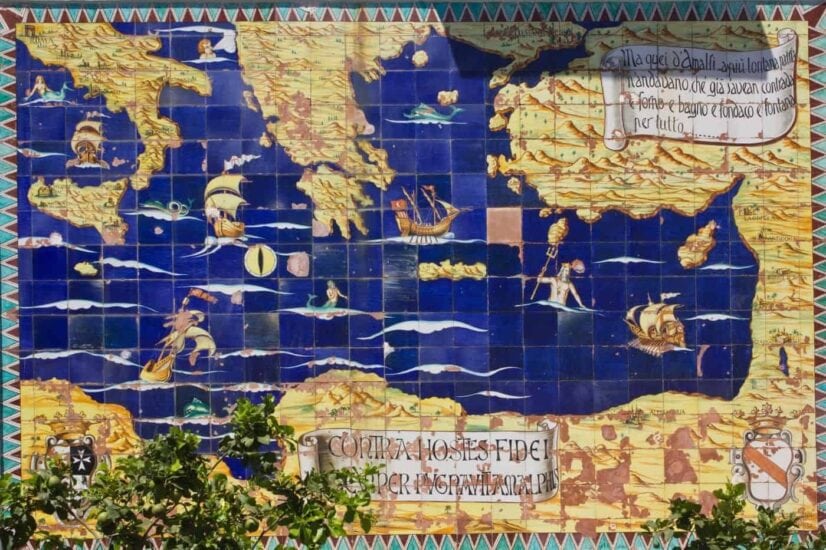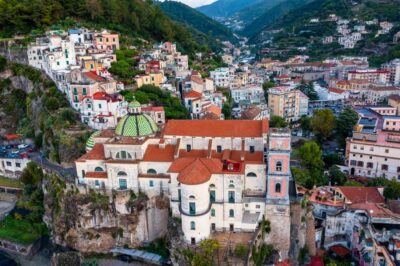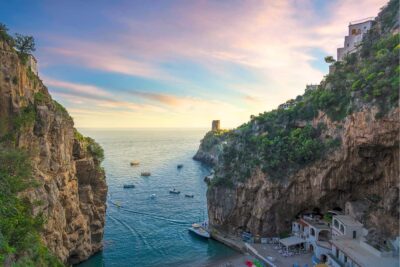You have probably seen the Amalfi Cathedral, perhaps you have already visited it, or you have put it on your list of must-sees on the Amalfi Coast.
You probably know about sfusato amalfitano, which is used to make sorbets and ice cream, sweets and savoury delicacies. You may be aware of the fascinating Historical Regatta, which thrills enthusiasts every year and brings an incredible number of travellers to Amalfi.
Perhaps, however, you don’t know about the tradition of the Amalfi paper, a truly ancient and fascinating tradition, which still today keeps alive a unique and precious product that deserves a place on your Amalfi Coast shopping list.
Indice dei contenuti
The Amalfi paper: from the Middle Ages to today
The Amalfi paper produced by hand in the Valle dei Mulini was one of the main activities of the Amalfi people in the past.
The production of Amalfi paper began between the 12th and 13th centuries. It was probably the Arabs who imported paper to the West, having learnt the processing techniques from the Chinese. The people of Amalfi, who had been in close contact with the ports of the eastern Mediterranean for centuries, proved to be quite skilful in learning the art of the ‘magistri in arte cartarum’, thus giving rise to the made-in-Italy production of paper.
This activity proved to be very profitable and the Amalfitans had everything they needed to become real experts, from the raw material to the energy to run the mills. At a time when electricity did not yet exist, the hydraulic energy obtained from the Canneto river proved much more useful.
The paper was called ‘charta bambagina’. There is much speculation about this name, although it is very likely that the word in medieval Latin ‘Bambax’ originated from Greek, meaning, in fact, ‘cotton’. Frederick II in 1200 forbade the use of bambagina paper by the notaries of the Curia because it was too light, requiring that deeds be written on parchment, which was much stronger.
Nonetheless, Amalfi paper continued to be produced and appreciated. Towards the end of the 18th century, the Valle dei Mulini counted about 16 paper mills hidden among citrus groves and waterfalls, a surreal scenario that attracted artists and poets who flocked from all parts of the old continent to put the beauty of this place down on paper (strictly Amalfi paper).
Paper production was also widespread in the valleys of Maiori and Minori, which, together with Amalfi, still today preserve numerous monumental remains of this activity, suggestive places to visit and recommended for lovers of excursions and industrial archaeology.
The Amalfi Papermaking Process
The manufacturing process of Amalfi paper is very fascinating and consisted of several stages. The linen, cotton and hemp rags were placed in stone vats called ‘piles’ where they were ground to a pulp with the help of wooden hammers with nails. The nails were located at the ends and were of various sizes, depending on the weight and thickness of the sheets of paper to be obtained. The wooden hammers were not used by hand because they were very heavy. Using the force of the water that fell on a wheel and acted as a counterweight, the slowly moving drive shaft started up.
After the paste was obtained, it was transferred to a tub into which the mould was lowered, i.e. a wooden frame with a weave of brass and bronze threads in the centre that formed the watermark. The paper had the papermakers’ trademark watermark, which was invisible to the naked eye; only by placing the sheet against the light could one see the heralds and civic and religious symbols. The oldest Amalfi paper sheets date back to the 13th and 14th centuries and feature the town’s coat of arms or the eight-pointed cross.
Going back to the process of making Amalfi paper, when the paste stuck to the mould the water was allowed to drain off and then transferred onto the wool felt creating a pile of sheets pressed by a wooden press to remove all the excess water. Moving towards the final stages of paper production, after being detached they were taken to the ‘spandituro’, a tool for the drying process, which was located at the highest point of the paper mill to allow the wind to act quickly.
Finally, the sheets were ironed in the smoothing room. From the 18th century, wooden hammers gave way to a much more precise Dutch machine with which a finer mash was produced. The watermarks were attached to metal cylinders and the paste, which passed automatically through masonry pipes, came off without human intervention. For drying, a steam boiler was introduced to treat the sheets before they were placed in the spreaders.
Amalfi paper was used for official documents of the duchy and was in use in the courts of the Angevins, the Aragons and the Bourbons. Undoubtedly, the quality watermark made the paper much more valuable than the others, which is why rummaging through historical archives you may come across ancient documents written on Carta di Amalfi. Another use of Carta di Amalfi was for communications other than official ones such as wedding announcements and court invitations.
Today, Carta di Amalfi is still produced and used by the Vatican State for correspondence, and is also in great demand for important occasions and for the publication of elegant literary works.
Paper Museum: where is it and how to visit it

The Paper Museum is located in Amalfi in Via Delle Cartiere, 24.
To reach it, once you are in Amalfi, take the state road 163 and at the roundabout in Piazza Flavio Gioia, turn right into Via Lorenzo D’Amalfi and walk straight on, crossing the town centre and Via Pietro Capuano.
By public transport, on the other hand, one must rely on the SITA bus or the Travelmar sea service.
The museum was created inside a former paper mill by Cav. Nicola Milano, who was its historic owner. Since 1971, the ‘Fondazione Museo della Carta’ (Paper Museum Foundation) has been involved in the diffusion and dissemination of the ancient art of Amalfi papermaking.
Nicola Milano was born in Amalfi in 1903 and can be considered a veteran of papermaking. When he was only 13 years old, he was forced to abandon his studies to provide for his family after his father was called to war. It is thanks to his passion that Amalfi has a museum dedicated to paper, having run no less than three similar activities himself.
Unfortunately he was forced to close because he incurred exorbitant costs for transporting the paper, at that time in fact the road connections were not the best. And in 1969, the last paper mill closed its gates. Unable to break away from the Amalfi paper mill, it decided to create the Paper Museum.
Again, there was no shortage of problems due to Italian bureaucracy, but today the museum is an interesting reality where conservation has been accompanied by the revival of the ancient arts. During the guided tour one can also witness the making of sheets by hand and see the ancient mills driven by the waters of the Canneto stream in action.
The Paper Museum is generally open from 10 am to 6.30 pm. During the winter months, it follows a slightly different schedule: from 1 November to 31 January, it is open from 10 a.m. to 4 p.m. From 27 December to 6 January, it is open from 10 a.m. to 6.30 p.m.; it is closed on 25, 15, 16 December and generally from the end of January until the end of February.
As opening hours are subject to change, we recommend that you check before your visit by calling + 39 0898304561 or by sending an email to info@museodellacarta.it.
A ticket will be charged.









